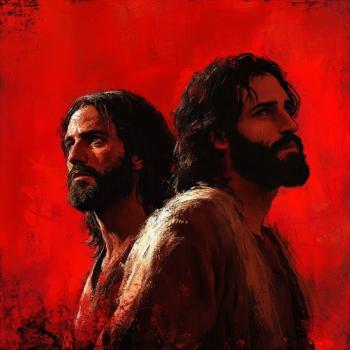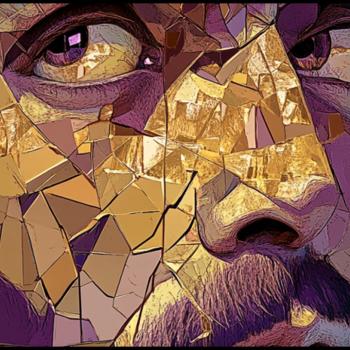
A recent article in The Daily Beast has stirred a bit of controversy regarding the suggestion by some scholars that the Virgin Mary was actually a slave of Joseph’s rather than his wife.
According to Dr. Mitzi J. Smith, the J. Davison Philips Professor of New Testament at Columbia Theological Seminary, and Professor of Gender Studies at the University of South Africa, there’s a clue in the Gospel of Luke that Mary was, in fact, a slave.
Here’s why this might be true. Because in Luke’s Gospel Mary identifies herself to the angel Gabriel as a “doule”, which, in the Greek, is the word for “enslaved girl.” [See Luke 1:38]
As the article says, “If we were reading any other ancient text written in Greek, we would assume that Mary was enslaved.”
According to Smith, “Any first-century reader, of any ethnicity, culture or religion, living under the Roman empire – a slave society where a significant segment of the population was enslaved and an empire that relied on slave labor – would have taken Mary’s self-designation as an enslaved woman seriously and as a declaration of her material or physical lived reality and not simply as a metaphor. And we should too.”
The article continues:
The problem is that this is not how English translations (or other modern translations) render the Greek. The New Revised Standard Version, for example, reads: “Here am I, the servant of the Lord; let it be with me according to your word.” The problem, Smith said, is that when translators approach the text they come to it with their own set of relatively modern culturally determined biases. Bear in mind that when the masculine form of “enslaved person” (doulos) is found in the Gospel of Luke it has consistently been translated as “slave.”
The translational hiccup is bigger than just English versions of the Gospel of Luke. As Clarice Martin, Smith, and others have noted, translators understand doulos to mean an enslaved person in almost every instance it appears in the New Testament. The exceptions are those occasions when it refers to someone we understand to be theologically important (e.g. Mary, Moses, the apostle Paul, or the disciples) or people with whom Christians identify (e.g. followers of Jesus in general). Translating doulos as “servant,” writes Martin, “minimizes the full psychological weight of the institution of slavery itself.” There’s nothing emancipatory about altering Mary’s social status: doing this obscures the realities of ancient people’s lives.
So, you can see why this article and these ideas have created a bit of a stir among many Evangelical Christians, and Catholics. They don’t like the idea of their faith hero – the Mother of Jesus – to be labelled as an actual slave. Mostly because, in the ancient world, if your mother was a slave, you were too.
That means that not only was Mary a slave, so was Jesus.
While this new perspective challenges many of our assumptions about Jesus and his family, it shouldn’t really trouble us all that much.
The Apostle Paul confirms such a notion in Philippians when he tells us to emulate the example of Christ who, not only took on human likeness and form, but who also, “…made himself nothing by taking the very nature of a servant [literally “slave”], being made in human likeness.” [Phil. 2:7]
So, just for a moment, let’s stop and consider the implications of this idea that Jesus and Mary were both the slaves of Joseph. It would explain a lot about the early life of Jesus. For example, slaves were not given their freedom until they reached the age of 30, by decree of the Emperor Augustus in 4 AD. So, perhaps that explains why the scriptures are silent about the first 30 years of Jesus’s life, and why he waited until the age of 30 to begin his ministry.
Understanding Jesus as a formerly enslaved person provides greater insight into his compassion for “the least of these,” doesn’t it? It offers us a window into the everyday reality of most of those who lived during this time period as subjects and literal slaves to their Roman [and sometimes Jewish] masters.
Slavery was extremely common. Women were often taken as slaves by older men. Almost everyone at this time either was a slave, owned a slave, or knew people who were enslaved.
But, what about the texts that suggest that Mary was “betrothed” to Joseph? Doesn’t that prove that she was the wife and not the slave of Joseph? Well, not exactly.
See, marriage in the ancient world was little more than slavery itself. The word for “wife” is literally just the common word for “woman” and the word for “marriage” throughout the Bible is actually just the word “to take.” So, when we read our English translations of the Scriptures and come across a verse that says something like, “and a man shall leave his father and mother and cleave to his wife”, it actually reads that a man shall leave his family and cleave to his “woman.”
The references to “marriage” in the Old Testament, for example are all about the men – or their fathers – who “take a woman” for the purpose of procreation. There is no reference to a woman ever “taking” a man to be her husband.
In fact, according to the Old Testament scriptures, the marriage arrangement was always a contract between two men: the father of the man and the father of the woman to be taken by that man.
Marriage was never a sacred or holy arrangement. No priest was ever involved. No temple ceremony ever took place. The transaction was closer to buying a used vehicle from your neighbor than anything else we can compare it to today.
In fact, the Christian church only declared marriage one of the sacraments in the 1500s. Before that, marriage was an entirely secular business arrangment.
So, whether Mary was a slave of Joseph’s or literally married to him would make almost no substantial difference to the quality of her life. Married women were, for all intents and purposes, slaves of their husbands who could divorce them at will and cast them out into the streets to fend for themselves at any point in their relationship. The woman had no power in the marriage. The man had all the power.
This is, incidentally, why Jesus shocks even his own disciples when he suggests in Matthew’s Gospel that the ONLY reason for a man to divorce his wife is for the sin of adultery. Why was that so shocking? Because it meant that the power to break the marriage covenant was essentially in the hands of the woman, not the man. Unless, of course, the man wanted to commit adultery, but then he would illicit the shame that went along with that sin. So, that meant the woman – not the man – had the power to end the marriage covenant, according to Jesus. The entire point was to empower women and end the abuse of women by their husbands who could threaten to divorce them at any time.
How do we know this is true? Because the reaction of Jesus’s own disciples when he says this is: “If this is the situation between a husband and wife, it is better not to marry.” Their response betrays the fact that they understood what Jesus was saying – you have to remain married until your wife decides she’s found a better husband. That idea prompted them to exclaim: “Then why get married at all?” To which Jesus says, essentially, “You’re right! In fact, perhaps you should consider becoming eunuchs for the Kingdom of God and give up on marriage entirely?” [see Matthew 19:11-12]
At any rate, Mary’s status as an enslaved woman would make a lot of sense to those in the First Century who either owned slaves or were slaves themselves. Nothing would have shocked them to know that Jesus had been born a slave, or that his mother was a slave. Most people were. And if Jesus was born a slave, and waited to begin his ministry until he turned 30 and earned his freedom, it would make so many of Jesus’s sayings from the Sermon on the Mount resonate with greater authority and power. Especially statements like, “Blessed are the meek, for they shall inherit the earth,” or “Blessed are you who are poor, for yours is the Kingdom of heaven.”
Just imagine a former slave standing up before the crowd and proclaiming freedom for the oppressed, salvation for the poor, blessings for the enslaved, and God’s favor towards those living at the edge, and the bottom, of society. If anything, Jesus’s status as a former slave would have added immeasurable weight and power to his words and his audience would have accepted him as one of their own and not as an entitled free man who had no idea what the harsh realities of their life was really like.
If Mary was Joseph’s slave, then perhaps he had other slaves, and other wives. There’s no reason to think Mary was the only woman in his household. Perhaps the brothers and sisters of Jesus mentioned later in the Gospels were the free children of Joseph? Perhaps that’s why James, the brother of Jesus, isn’t present at the crucifixion and doesn’t take Mary under his household care the way a true son would have been expected to do upon the death of an older brother. This may be why Jesus says to the disciple he loved, “Behold your mother,” and to Mary, “behold your son,” because there were no other children to care for her, and perhaps this meant that this unnamed disciple actually took Mary as a slave in his own household.
Even if not, these are good ideas and notions to ponder and to consider. We should never be offended at the idea that Mary was more than a metaphorical slave or that Jesus was actually a literal slave until he turned 30. If anything, it makes these concepts more powerful, more real, and frankly, more believable.
What do you think?
**

Are you looking for a safe place to ask your faith questions? Need a strong community of people who understand the pain of deconstruction? Our Square 1 course and community is looking for people like you to join us starting January 9th, 2023. This 12-week online experience is designed to help you walk through your deconstruction journey to discover for yourself what your reconstruction process looks like. Our thriving Square 1 community is wide open to your doubts, questions and uncertainty.
Register today for 75% off and make plans to join us in Square 1.
Keith Giles is the best-selling author of the Jesus Un series. He has appeared on CNN, USA Today, BuzzFeed, and John Fugelsang’s “Tell Me Everything.” His latest book, SOLA MYSTERIUM: Celebrating the Beautiful Uncertainty of Everything is available now on Amazon in paperback and on Kindle.













